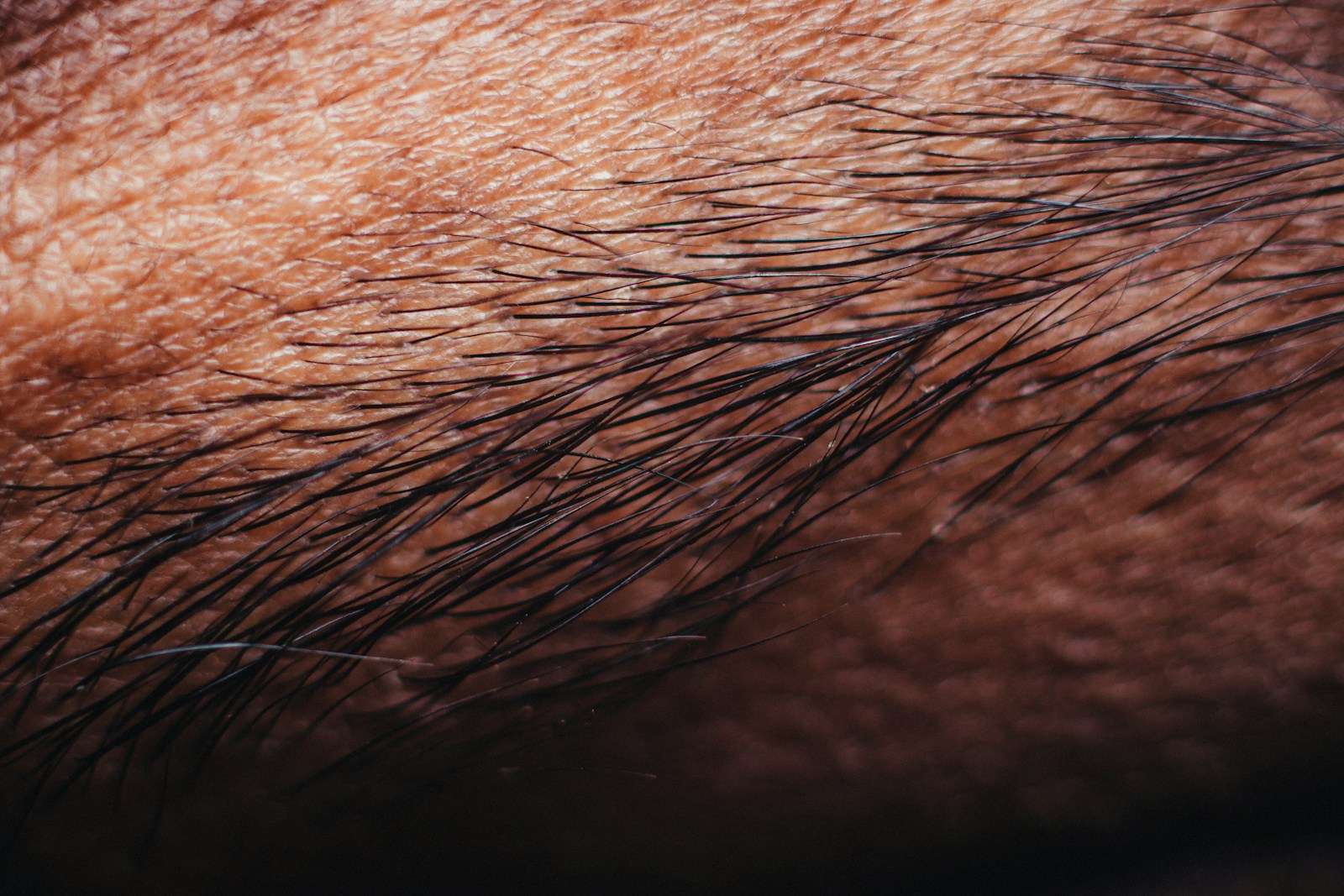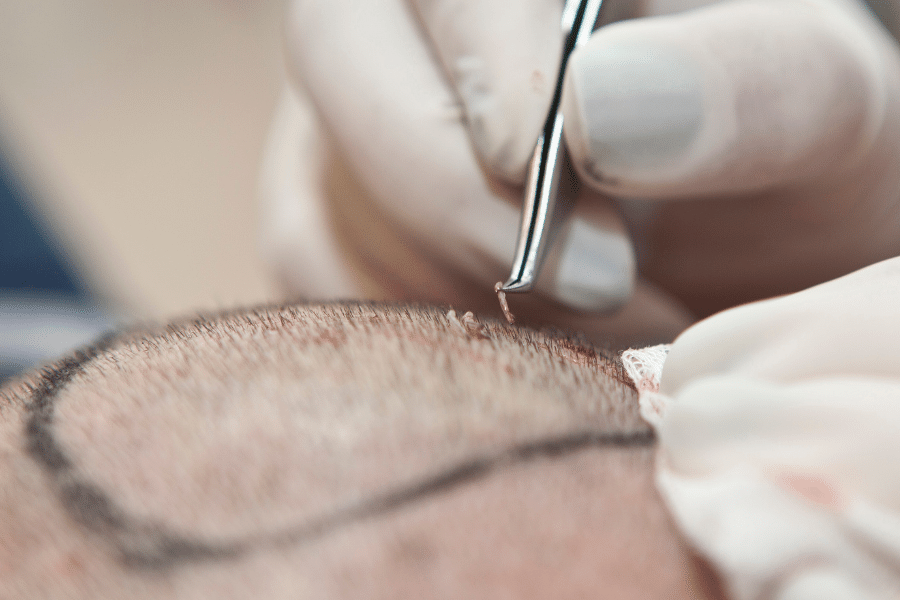What is Direct Hair Implantation (DHI) Technique?
Direct Hair Implantation (DHI) Technique is an innovative hair transplant method that ensures natural-looking results and faster recovery time compared to traditional hair transplant techniques. This technique uses a specialized tool called the Choi Implanter Pen, which allows for precise and controlled implantation of hair follicles.
İçindekiler
Unlike other hair transplant methods, DHI does not require the extraction of a strip of scalp or the creation of multiple incisions. Instead, individual hair follicles are harvested from the donor area and immediately implanted into the recipient area using the Choi Implanter Pen. This minimizes the risk of damage to the follicles and ensures their survival and growth.
DHI is suitable for both men and women experiencing hair loss or thinning. Candidates must have a sufficient supply of healthy donor hair follicles for transplantation. Factors such as age, overall health, and the type of hair loss will also be considered before opting for Direct Hair Implantation.
Overall, the Direct Hair Implantation (DHI) technique offers numerous benefits such as natural-looking results, faster recovery time, and minimally invasive procedures, making it a popular choice for individuals seeking hair restoration.
Introduction to Direct Hair Implantation (DHI)
Direct Hair Implantation (DHI) is an advanced technique in hair transplantation that ensures natural-looking results and faster recovery time compared to traditional methods. It is a minimally invasive procedure that involves the precise and controlled implantation of hair follicles using a specialized tool called the Choi Implanter Pen.
Unlike other techniques, DHI does not require the extraction of a strip of scalp or the creation of multiple incisions. Instead, individual hair follicles are harvested from the donor area and immediately implanted into the recipient area. This reduces the risk of damage to the follicles and ensures their survival and growth.
The key advantage of DHI is that it allows for precise placement of hair follicles, mimicking the natural hair growth pattern. This results in a more natural and seamless appearance. Additionally, the faster recovery time associated with DHI allows patients to resume their daily activities sooner.
Overall, the Direct Hair Implantation (DHI) technique offers an effective solution for individuals seeking natural-looking hair restoration with minimal downtime.
How Direct Hair Implantation (DHI) differs from other hair transplant techniques
Direct Hair Implantation (DHI) stands apart from other hair transplant techniques due to its unique approach. Unlike Follicular Unit Extraction (FUE) and Follicular Unit Transplantation (FUT), DHI does not require the extraction of a strip of scalp or the creation of multiple incisions. Instead, individual hair follicles are directly extracted from the donor area and immediately implanted into the recipient area using the Choi Implanter Pen.
This precise and controlled implantation technique allows for a higher survival rate of the transplanted hair follicles. Moreover, the Choi Implanter Pen ensures the natural direction and angle of hair growth, leading to a more seamless and natural-looking result.
Compared to traditional methods, DHI also offers a faster recovery time. Patients can resume their regular activities sooner and experience minimal discomfort post-surgery.
DHI is an ideal choice for individuals seeking a minimally invasive procedure that provides natural-looking results, faster recovery, and precise placement of hair follicles. Its advanced techniques and innovative tools make it a popular choice in the field of hair transplantation.
Benefits of Direct Hair Implantation (DHI)
Direct Hair Implantation (DHI) offers a range of benefits that make it a preferred choice for individuals seeking hair restoration. One of the primary advantages of DHI is the natural-looking results it produces. The precise implantation technique using the Choi Implanter Pen ensures that hair follicles are placed in the correct direction and angle, mimicking natural hair growth patterns. This leads to a seamless and undetectable outcome.
In addition to the aesthetic benefits, DHI also provides a faster recovery time compared to traditional hair transplant methods. Since there are no incisions or strip extraction involved, patients experience minimal discomfort and can resume their regular activities soon after the procedure.
Furthermore, the survival rate of transplanted hair follicles with DHI is higher due to the direct extraction and implantation process. This means that patients can expect a higher percentage of hair follicles to grow and thrive in the recipient area, resulting in denser and fuller hair.
Overall, DHI offers natural-looking results, faster recovery, and precise placement of hair follicles, making it a highly effective and sought-after hair transplantation technique.
Natural looking results with DHI
DHI stands out among other hair transplant techniques due to its ability to deliver natural-looking results. The precision and meticulousness involved in the DHI process ensure that the transplanted hair follicles are implanted in the correct direction and angle, mirroring the natural growth patterns of the patient’s existing hair. This attention to detail allows for a seamless and undetectable outcome, as the transplanted hair blends seamlessly with the surrounding hair.
With DHI, patients can achieve hair that not only looks natural but also feels natural to the touch. The Choi Implanter Pen used in DHI procedures enables precise and controlled implantation of individual hair follicles, ensuring a higher density and more natural distribution of transplanted hair.
Whether the goal is to restore thinning hair, create a new hairline, or fill in bald patches, DHI can provide natural-looking results that boost confidence and enhance one’s appearance. By choosing DHI, individuals can expect a hair restoration solution that not only addresses their concerns but also delivers aesthetically pleasing and undetectable results.
Faster recovery time compared to traditional hair transplants
One of the key benefits of the DHI technique is its faster recovery time compared to traditional hair transplants. With DHI, patients experience minimal downtime and can resume their regular activities soon after the procedure. This is because the DHI technique uses a specialized Choi Implanter Pen to extract and implant individual hair follicles, minimizing trauma to the scalp and reducing healing time.
Traditional hair transplant methods, such as Follicular Unit Extraction (FUE) or Follicular Unit Transplantation (FUT), often involve larger incisions or harvesting of a strip of scalp, which requires more healing time. DHI, on the other hand, uses a precise and minimally invasive approach that promotes faster healing and reduced scarring.
This faster recovery time allows patients to return to work and social activities sooner, without having to worry about extended downtime. The minimal discomfort and rapid healing associated with DHI make it an attractive choice for those seeking a hair transplant procedure with minimal interruption to their daily lives.
How Direct Hair Implantation (DHI) Works
Direct Hair Implantation (DHI) is a hair transplant technique that involves the extraction and implantation of individual hair follicles using a specialized Choi Implanter Pen. The process starts with the extraction of healthy hair follicles from the donor area, which is usually the back or sides of the scalp.
The extracted hair follicles are then carefully implanted into the recipient area of the scalp, where hair loss has occurred. The Choi Implanter Pen, which has a hollow needle with a diameter similar to the hair follicles, is used to create tiny incisions and precisely place each hair follicle into the desired area.
The advantage of the Choi Implanter Pen is that it allows for the direct implantation of hair follicles without the need for prior creation of recipient sites. This minimizes the time the hair follicles spend outside the body, increasing their chances of survival and improving the overall success of the procedure.
The precise and meticulous placement of each hair follicle ensures a natural-looking hairline and optimal hair growth. The DHI technique offers a reliable and effective solution for those seeking to restore their hair density and regain a youthful appearance.
Process of extracting and implanting hair follicles using DHI technique
In the Direct Hair Implantation (DHI) technique, the process begins with the extraction of healthy hair follicles from the donor area, which is typically the back or sides of the scalp. This is done using specialized instruments that ensure minimal damage to the follicles.
Once the hair follicles are extracted, they are carefully implanted into the recipient area of the scalp, where hair loss has occurred. The unique aspect of DHI is the use of the Choi Implanter Pen, which has a hollow needle similar in diameter to the hair follicles. This pen allows for the direct implantation of hair follicles without the need for prior creation of recipient sites.
The surgeon uses the Choi Implanter Pen to create tiny incisions and precisely place each hair follicle into the desired area. This meticulous placement is essential for achieving natural-looking results and optimal hair growth.
By ensuring the hair follicles spend minimal time outside the body, DHI increases their chances of survival and improves the overall success of the procedure. The process of extracting and implanting hair follicles using the DHI technique is a precise and meticulous process that helps restore hair density and create a youthful appearance.
Advantages of Choi Implanter Pen in DHI procedures
The Choi Implanter Pen used in Direct Hair Implantation (DHI) procedures offers several advantages. Firstly, it allows for the precise placement of hair follicles into the recipient area without creating prior incisions. This helps to minimize trauma to the scalp and ensures maximum graft survival.
The use of the Choi Implanter Pen also enables the surgeon to control the depth and angle of hair follicle implantation, leading to more natural-looking results. This precision is essential in recreating the natural hairline and ensuring that transplanted hair grows in the desired direction.
Additionally, the Choi Implanter Pen reduces the overall procedure time compared to other techniques, as it eliminates the need for separate incisions and implantation steps. This shorter procedure time can be advantageous for both the patient and the surgeon.
Overall, the Choi Implanter Pen enhances the success rate of DHI procedures by improving the survival and growth of transplanted hair follicles, and it plays a crucial role in achieving aesthetically pleasing and natural results.
Candidates for Direct Hair Implantation (DHI)
Ideal candidates for Direct Hair Implantation (DHI) are individuals who are experiencing hair loss or baldness and are looking for a permanent solution to restore their hair. DHI is suitable for both men and women who have sufficient donor hair on their scalp or other areas of their body.
Candidates for DHI should have a stable hair loss pattern, as the procedure does not prevent further hair loss. It is important for patients to have realistic expectations about the results and understand that the transplanted hair will grow naturally and gradually over time.
Factors to consider before opting for Direct Hair Implantation include the overall health of the candidate. They should not have any medical conditions that may interfere with the healing process. Additionally, candidates must be committed to following post-operative care instructions to ensure optimal recovery and long-term hair growth.
Consulting with a qualified hair transplant surgeon is essential to determine if the candidate is suitable for DHI and to discuss personalized treatment plans based on their individual needs and goals.
Ideal candidates for DHI procedures
Ideal candidates for Direct Hair Implantation (DHI) procedures are individuals who are experiencing hair loss or baldness and are seeking a permanent solution to restore their hair. DHI is suitable for both men and women who have sufficient donor hair on their scalp or other areas of their body.
These candidates should have a stable hair loss pattern, as the DHI procedure does not prevent further hair loss. It is important for patients to have realistic expectations about the results and understand that the transplanted hair will grow naturally and gradually over time.
In addition, candidates for DHI should be in good overall health and not have any medical conditions that may interfere with the healing process. They should also be committed to following post-operative care instructions to ensure optimal recovery and long-term hair growth.
Consulting with a qualified hair transplant surgeon is essential to determine if the candidate is suitable for DHI and to discuss personalized treatment plans based on their individual needs and goals. By ensuring that they meet the criteria for an ideal candidate, individuals can achieve the best possible results with DHI.
Factors to consider before opting for Direct Hair Implantation
Before opting for Direct Hair Implantation (DHI), there are several important factors to consider. Firstly, it is crucial to have a thorough consultation with a qualified hair transplant surgeon to assess your suitability for the procedure. The surgeon will evaluate factors such as your age, overall health, and the extent of your hair loss to determine if DHI is the right option for you.
Additionally, it is important to have realistic expectations about the results. DHI can provide natural-looking hair restoration, but it may not be able to completely restore your hair to its original density. Understanding the limitations of the procedure will help you set realistic goals.
Financial considerations are also important to take into account. DHI is a specialized technique that may involve higher costs compared to other hair transplant methods. It is important to have a clear understanding of the total cost of the procedure, including any follow-up treatments or medications.
Lastly, it is important to consider the time commitment required for the DHI procedure. The process may take several hours or even multiple sessions depending on the extent of hair loss. It is crucial to choose a time when you can comfortably accommodate the procedure and the recovery period.
Overall, considering these factors will help you make an informed decision about whether Direct Hair Implantation is the right choice for you.
Direct Hair Implantation (DHI) vs. FUE and FUT Techniques
When comparing Direct Hair Implantation (DHI) to other hair transplant techniques such as Follicular Unit Extraction (FUE) and Follicular Unit Transplantation (FUT), there are a few key differences to consider.
Firstly, DHI utilizes a specialized Choi Implanter Pen to directly implant individual hair follicles into the recipient area, bypassing the need for creating recipient sites beforehand. This precision allows for more natural-looking results and a higher survival rate of the transplanted hair follicles.
In contrast, FUE involves manually extracting individual hair follicles using a punch tool and then implanting them into recipient sites created by the surgeon. FUT, on the other hand, involves removing a strip of hair-bearing scalp from the donor area and then dissecting it into individual follicular units for transplantation.
One advantage of DHI over FUE and FUT is that it requires less handling of the grafts, which minimizes the risk of damage or transection. Additionally, DHI requires no sutures or stitches, resulting in a faster recovery time and no linear scar.
Overall, DHI offers a more advanced and precise technique for hair transplantation, resulting in superior natural-looking results and minimal downtime for patients.
Comparison between DHI, Follicular Unit Extraction (FUE), and Follicular Unit Transplantation (FUT)
When comparing Direct Hair Implantation (DHI) with other hair transplant techniques like Follicular Unit Extraction (FUE) and Follicular Unit Transplantation (FUT), it is important to consider the differences in their procedures and outcomes.
DHI stands out as a more advanced technique that offers superior natural-looking results. Unlike FUE and FUT, DHI uses a Choi Implanter Pen to directly implant individual hair follicles into the recipient area, without the need for creating recipient sites beforehand. This ensures precise placement and a higher survival rate of the transplanted hair follicles.
In contrast, FUE involves manually extracting individual hair follicles and then implanting them into recipient sites created by the surgeon. FUT involves removing a strip of hair-bearing scalp and dissecting it for transplantation.
DHI also has advantages over FUE and FUT in terms of graft handling. DHI involves less handling, minimizing the risk of damage or transection. Additionally, DHI requires no sutures or stitches, resulting in a faster recovery time and no linear scar.
Overall, DHI offers a more advanced and precise technique for hair transplantation, providing natural-looking results and minimal downtime for patients.
Advantages of DHI over other hair transplant methods
DHI offers several advantages over other hair transplant methods such as Follicular Unit Extraction (FUE) and Follicular Unit Transplantation (FUT). One of the key advantages is the precision and natural-looking results that DHI can achieve. The use of Choi Implanter Pen in DHI allows for the direct implantation of hair follicles, ensuring accurate placement and a higher survival rate of the transplanted hair.
In addition, DHI requires less graft handling compared to FUE and FUT. This minimizes the risk of damage or transection to the hair follicles, resulting in a higher success rate of hair growth. Furthermore, DHI does not require any sutures or stitches and leaves no linear scar, making it a more desirable option for those concerned about visible scarring.
Another advantage of DHI is the faster recovery time compared to traditional hair transplants. DHI procedures typically have minimal downtime, allowing patients to resume their normal activities sooner.
Overall, DHI provides a more advanced and effective technique for hair transplantation, offering natural-looking results, minimal downtime, and a higher success rate of hair growth.
Recovery and Aftercare following Direct Hair Implantation (DHI)
After undergoing the Direct Hair Implantation (DHI) procedure, it is important to follow the recommended post-operative care instructions for a smooth recovery and optimal results. The recovery period following DHI is generally shorter compared to traditional hair transplants.
Immediately after the procedure, patients may experience some mild discomfort, swelling, or redness in the treated area, but these symptoms typically subside within a few days. It is advised to avoid touching or scratching the scalp to prevent any damage to the newly implanted hair follicles.
In the first few days after DHI, patients should follow a gentle hair care routine, avoiding any strenuous activities, excessive sweating, or exposure to direct sunlight. It is important to keep the scalp clean and avoid harsh chemicals or styling products.
Over the following weeks, the transplanted hair will naturally shed, which is a normal part of the healing process. New hair growth usually starts to occur within 2-3 months after the procedure, and the full results can be expected within 9-12 months.
Regular follow-up consultations with the hair transplant specialist are essential during the recovery period to monitor progress and address any concerns. By following the aftercare instructions provided, patients can achieve successful and long-term hair growth with Direct Hair Implantation (DHI).
Post-operative care instructions for DHI patients
Following Direct Hair Implantation (DHI), it is crucial to adhere to proper post-operative care instructions for a successful recovery and optimal results. Here are some guidelines to follow:
- Avoid touching or scratching the scalp: It is essential to resist the temptation to touch or scratch the treated area, as this can disrupt the newly implanted hair follicles.
- Gentle hair care routine: In the initial days after the procedure, use a mild shampoo and gently cleanse the scalp without rubbing or massaging the area. Pat dry with a soft towel.
- Avoid strenuous activities and excessive sweating: Refrain from engaging in strenuous exercises or activities that may cause you to sweat profusely. Sweating can increase the risk of infection or dislodge the transplanted hair follicles.
- Protect from direct sunlight: Direct sunlight can be harmful to the healing scalp. Wear a hat or use sunscreen to shield the treated area when going outside.
- Do not use harsh chemicals or styling products: Avoid using harsh chemicals, hair dyes, or strong styling products on the scalp for a few weeks after the procedure.
By following these post-operative care instructions, patients can help ensure a smooth recovery and assist in the successful transplantation of hair follicles with Direct Hair Implantation (DHI).
Expected results and long-term hair growth with Direct Hair Implantation
After undergoing Direct Hair Implantation (DHI), patients can expect natural-looking results and long-term hair growth. The transplanted hair follicles will go through a shedding phase within a few weeks, which is a normal part of the process. However, new hair growth will begin in the following months as the implanted follicles start to take root.
Over time, these transplanted hairs will continue to grow and blend seamlessly with the existing hair, providing a fuller and denser appearance. The results of DHI are permanent and can last a lifetime, as the transplanted hair follicles are typically resistant to the effects of DHT, the hormone responsible for genetic hair loss.
It is important to note that the timeline for hair growth and the final results may vary from person to person. Patience is key during the recovery period, as it can take several months to see the full effects of the DHI procedure. By following the post-operative care instructions and attending follow-up appointments, patients can ensure optimal results and enjoy long-term hair growth.




